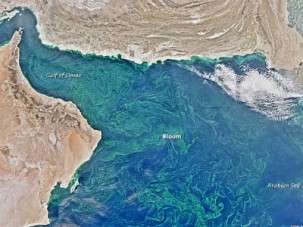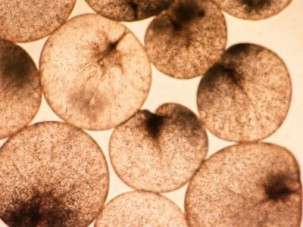An algorithm to investigate unwelcome plankton

Computer scientists at Columbia University will work with oceanographers to understand what has caused an unusual plankton-like species to rapidly invade the Arabian Sea food chain, threatening fisheries that sustain more than 100 million people living at the sea's edge.
In the last decade, the dinoflagellate Noctiluca scintillans has pushed out diatoms, the plankton species that traditionally supported the Arabian Sea food chain. Each winter, thick blooms of emerald green Noctiluca now carpet the sea, from Oman on the west, to India and Pakistan on the east. Under a two-year, $160,000 grant from Columbia's Office of the Executive Vice President for Research, researchers will try to pinpoint the factors driving Noctiluca's success. The research team includes Tony Jebara, a computer scientist at Columbia Engineering, and Joaquim Goes, Ryan Abernathey and Helga Gomes, oceanographers at Columbia's Lamont-Doherty Earth Observatory.
Using daily images of Noctiluca blooms captured from space, the researchers will analyze the blooms' evolution in the Arabian Sea. Ocean currents play some role in dispersing Noctiluca, but so do biological factors, like its growth rate, the number of predators it faces, and the amount of nutrients, light and oxygen available at the water's surface.
In the first phase of the project, the researchers will model how ocean currents would transport Noctiluca if currents alone were driving its spread. Comparing the model's results against the satellite pictures of what actually happened, they will calculate how much of Noctiluca's growth was caused by currents rather than biological factors. In phase two, they will use statistical machine learning techniques to infer the unknown physical and biological variables fueling Noctiluca's expansion. In particular, Bayesian machine learning methods can recover nonlinear dynamics as well as hidden variables to potentially predict the expansion patterns more accurately.
"Machine learning will help us find the underlying ecosystem dynamics responsible for the differences between the physical model results and the bloom evolution patterns seen in satellite images," said Abernathey, a physical oceanographer at Lamont-Doherty.

The project builds on earlier research led by Lamont's Gomes and Goes linking Noctiluca's rise in the Arabian Sea to an oxygen-starved dead zone the size of Texas. They hypothesize that nutrient-rich fertilizer and sewage flowing into sea are increasing productivity and expanding the dead zone as oxygen gets depleted. They also think that stronger winds tied to climate change are bringing more nutrients to the surface, contributing to the problem.
Native to the tropics, green Noctiluca has evolved to survive in murky and luminous waters alike. With a flick of its tail-like flagellum, it can dive down to eat plankton, living or dead, or swim up to the light, drawing energy from the millions of green algae, or "endosymbionts," living within its transparent cell walls. This flexibility gives it an edge on diatoms, which survive on sunlight alone.
During a research expedition off Oman in 2006, Goes and his colleagues discovered that Noctiluca had virtually replaced the winter diatom blooms. With shipboard experiments on subsequent cruises, they learned that Noctiluca handily outcompetes diatoms in low-oxygen water, and though Noctiluca is too big for the crustacean grazers one rung up on the food chain to eat, salps and jellies happily devour it.
Discover the latest in science, tech, and space with over 100,000 subscribers who rely on Phys.org for daily insights. Sign up for our free newsletter and get updates on breakthroughs, innovations, and research that matter—daily or weekly.
The researchers hypothesize that a boom in summer diatom blooms triggered the transition to winter Noctiluca blooms. Noctiluca is increasingly edging out diatoms during summertime, too, with potentially devastating consequences for the predator fish at the top of the food chain.
In a 2005 study in Science, Goes and his colleagues reported that stronger summer winds blowing toward India had increased diatom productivity off Oman by more than 300 percent. As snow retreats from the Himalaya-Tibetan plateau, the Indian subcontinent has grown hotter in summer compared to the Arabian Sea, causing the summer monsoon winds blowing toward India to strengthen. Stronger winds brought up more nutrients off Somalia, Yemen and Oman; they estimate that that this triggered a 350 percent increase in biomass between 1997 and 2004.

As plankton grows, it uses up oxygen in the water. The researchers hypothesize that falling oxygen levels allowed Noctiluca to outcompete diatoms during winter, a process that appears to now be underway in summer, too.
"Over the last four years our colleagues in Oman have seen large Noctiluca blooms peaking around September," said Goes. "These blooms are usually associated with low oxygen concentrations."
Goes and his colleagues, one of six teams at Columbia selected for the grants, will continue to explore Noctiluca's evolution.
"We saw an extraordinary collection of highly competitive applications this year," said G. Michael Purdy, Columbia's executive vice president for research. "The 2015 winning teams exemplify the ingenuity, creativity, and excellence that so well characterize Columbia's preeminent research enterprise."
More information: "Massive outbreaks of Noctiluca scintillans blooms in the Arabian Sea due to spread of hypoxia." Nature Communications 5, Article number: 4862 DOI: 10.1038/ncomms5862
"Warming of the Eurasian landmass is making the Arabian Sea more productive." Science. 2005 Apr 22;308(5721):545-7. www.ncbi.nlm.nih.gov/pubmed/15845852
Journal information: Nature Communications , Science
Provided by Earth Institute, Columbia University




















